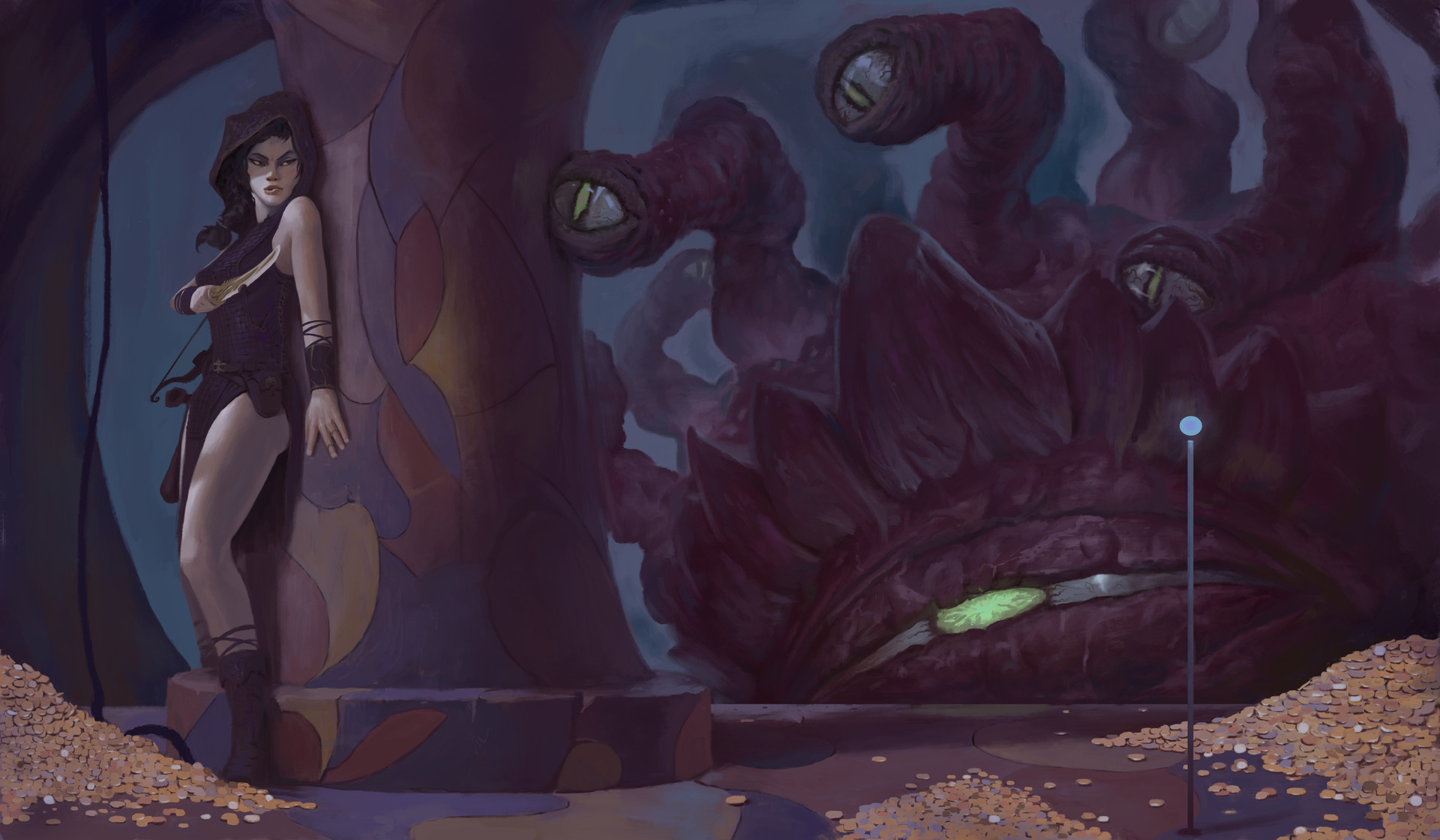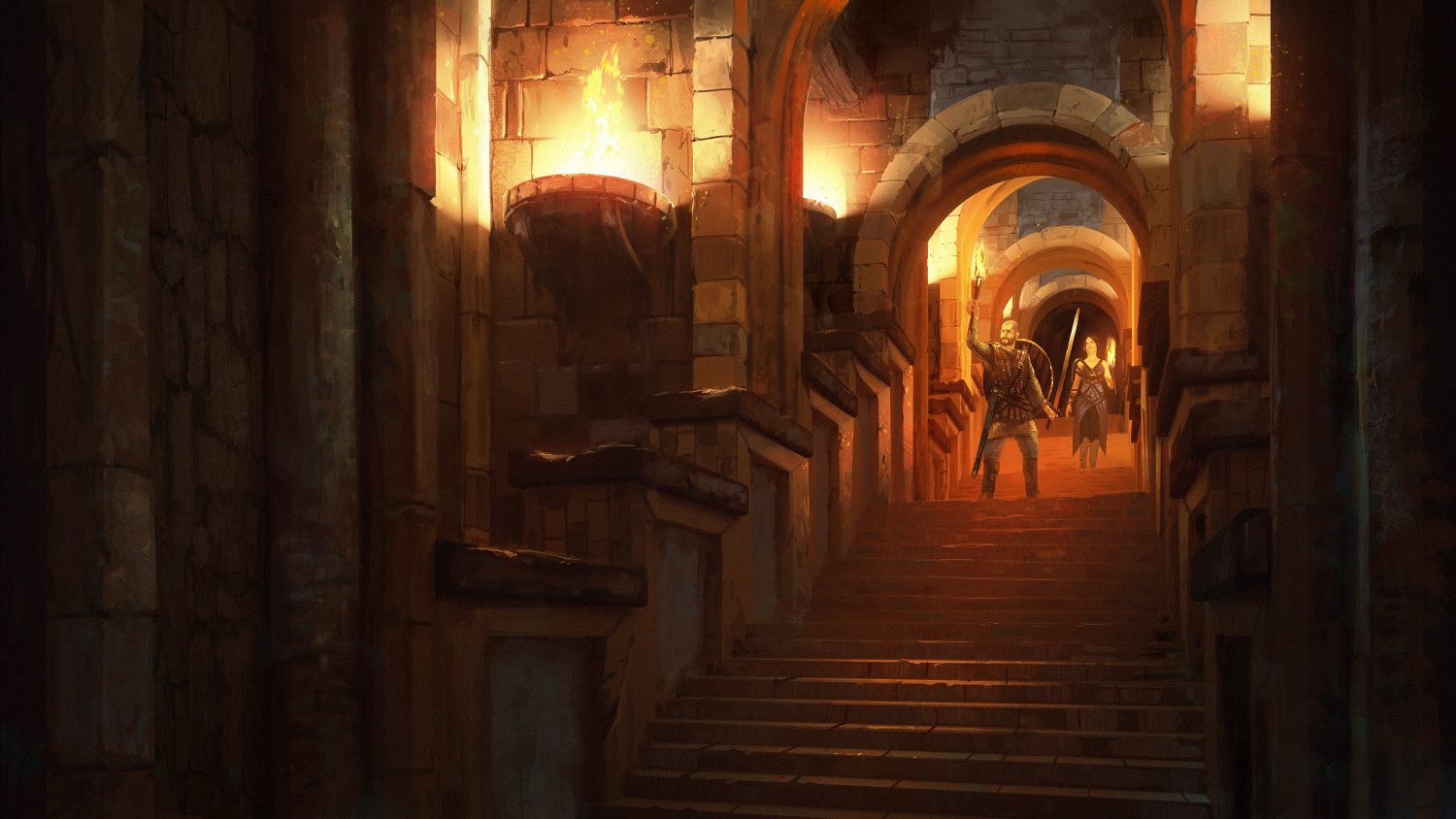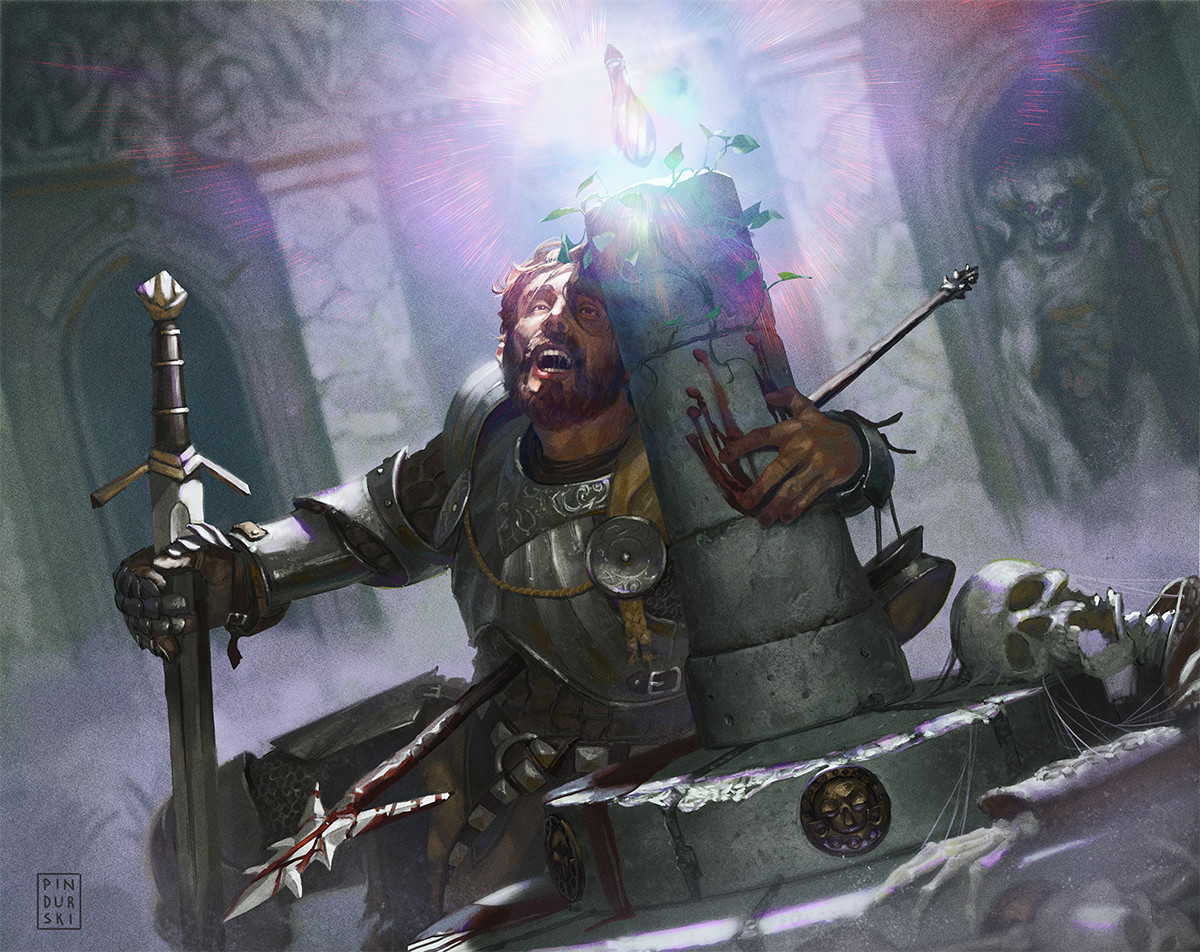Normally, an OD&D character can do any of these things if they are not under pressure. However, when sneaking through a place with patrols (such as a dynamic dungeon, guarded mansion, etc), the Thief Game begins.
Some things to note:
- A round is 10 minutes.
- " indicates multiply the number * 10 for feet, so 3" is 30 feet.
 |
| By Martin Sobr |
Playing the Thief Game
- Announce that the Thief Game is beginning.
- State the win condition:
- Escape with whatever the PCs are looking for.
- Assassinate a target.
- Get to a new area where they can hide/rest.
- Escape something that is searching for them.
- With these 4 things in mind, you get an idea of what triggers the Thief Game.
- Players always go first, with popcorn initiative.
- On their turn, the player describes what they want to do. The referee then decides mechanically what that is and rolls for it themselves. If they move, players can move 3" per round. The referee does not directly tell the player the results.
- After all players go, the referee does.
- PC skill checks are resolved on the referee's turn.
- Patrols (if any) then move.
- Any hazards (traps, etc) the PCs trigger are activated.
- Start the process over until the PCs are caught and cannot escape, the PCs die, or the PCs when the Thief Game.
 |
| Reflavor your lockpicks as different things. Like a trained cobra. |
Thief Skills
The following thief skills are what the referee rolls for when their players tell them what they want to do.
- Open Locks: Safely picking locks of any sort. Roll under D%
- Remove Traps: Disarm a discovered, but not yet triggered, trap. Roll under d%
- Phantom Touch: Remove something off someone/something without disturbing it. Roll under d%.
- Move Silently: Move without making any noise. Roll under d%. Can't be done in heavy armor.
- Hide in Shadows: Hide in gloom, obscured areas, or dim light. Roll under d%. Can't be done while holding a light source.
- Spider Climb: Climb a vertical surface with no handholds. Roll under d%. Can't be done in heavy armor.
- Hear Danger: Hear approaching patrols, or danger on the other side of a barrier. X-in-6 chance.
All d% chances start at 20% chances. Every HD adds +5% to the chance.
Hear Danger starts at 1-in-6. Every 3 HD (so at 3rd/6th/9th/12th/15th levels) it increases by +1.
Again, the referee rolls these checks and does not tell the player if they 100% succeed or not. I've found this maintains tension, and makes the referee's turn more enjoyable for me.
 |
| In a lot of cases, you will have to decide: Keep your light source, or win the Thief Game? |
Patrols
Patrols are any amount of creatures in a confined area that move in preset patterns while looking for intruders.
In your dungeon or confined space, have 1d6 patrols. Add +2d6 if the patrols are expecting the PCs.
Have a patrols route sketched out. Roll 1d4 when designing patrols. This is how many rounds it takes for a full patrol circuit to complete.
If a patrol discovers intruders, it will spend that round not doing anything other then discovering them. On its next round, should it still be alive, it will trigger some sort of alarm. In 2 rounds, every patrol will be in the area. On the third round, should the patrol still be alive and the PCs still in the area, it will initiate combat. This means the PCs have lost the Thief Game.
Losing the Thief Game
Once the PCs lose the Thief Game, they cannot begin it again. This is because if they escape, security will increase to the point where sneaking is virtually impossible in that particular area. Or, because the PCs have killed enough or make their enemies break and flee, thus removing all patrols.
 |
| Hazards keep the Thief Game fresh. More potential hazards leads to a more dynamic, dangerous And rewarding victory. |
Hazards
Hazards are traps, environmental things (like yellow ooze or cliffs), or supernatural shit (like hauntings, etc).
Put between 2-10 hazards in each Thief Game. The more hazards, the more difficult things are.
Hazards usually do damage or put the PC into a bad spot. If they do damage, use these guidelines
- For non-lethal hazards, roll 2d6 and take the lower amount.
- For standard hazards, like spike traps and the like, roll 1d6.
- For supernatural hazards, like spell traps, roll 2d6 and take the higher amount.
Here's a sample stat block template for making a hazard
Hazard Name:
Hazard Trigger: A simple trigger.
Hazard Description: 1 line for most hazards. 2-4 for complex ones.
Hazard Damage: Based off the above guidelines.
An example hazard:
Rolling Boulder
Trigger: Removing something on a pressure plate.
- A boulder drops behind the creature in a sloping passage, blocking that direction and rolling at 60" a round behind them, dealing 1d6 dmg if it reaches their space, and another 1d6 every round after until freed.
Notice that in the above, no solution to the trap is given. If discovered as a trap beforehand, a roll can remove it, or player ingenuity. If caught in the trap, only player ingenuity can save them.
 |
| Burglary should always pay off. |
Rewards for the Thief Game
Players should feel rewarded for winning the Thief Game. Discovering precious treasure maps, magical items, or valuable information are the standards. Also, they avoided a lot of combat (hopefully) and got to a new place.
Another cool Thief Game reward is having the party discover a new entrance/exit to wherever they're going, so that they don't have to do all this sneaking again.
I generally like this idea; you've designed some cool sub-games in the past, and also I agree that the OD&D Thief (or at least the LotFP Specialist, which is the closest thing I'm reasonably familiar with) feels like bad / dated design by modern standards. However, I think there could still be a place for a Thief class, but instead of a clunky mechanic that makes Thieves only useful at sufficiently high levels, only for thief-stuff, and making every other class useless at it (and by extension demanding somebody be a thief and the GM plan accordingly), just make the thief geared towards this thief sub-game. In any case, I've been interested in your game design work for some time now and look forward to seeing it altogether.
ReplyDeleteWhy do you have hear danger to be at d6 instead of d%, when the probabilities are so similar?
ReplyDeleteOnly reason is because of the fact that for the actual thief, they use a X-in-6 chance. In the final version of this, I'll likely move it to a d% roll as well
Delete5 years ago I had warts, I was treated with some liquid applied to the warts they continued to grow and spread... The next 2 doctors did laser surgery to remove them. 1 year after the surgery, they grew back close to where the 1st ones were' so I was finally told it was hpv. I have had it for very long time, I contract it from my cheated boyfriend and I found out he was also infected and I end up the relationship between us. the warts was so embarrasses because it started spreading all over I have be dealing with this things for very long time the last treatment I take was About 2 years ago I applied natural treatment from Dr onokun herbal cure, a week after applying the treatment all the warts was gone. it's now 2 years and some months I don't have single wart or any symptoms of hpv. wow"" it's great, Dr onokun has finally cured me. Anyone living with hpv contact Dr onokun for natural treatment.
ReplyDeleteHis email address: dronokunherbalcure@gmail.com